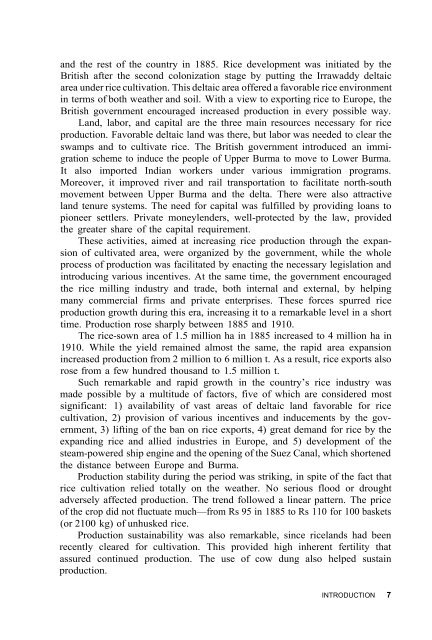A century of rice improvement in Burma - IRRI books - International ...
A century of rice improvement in Burma - IRRI books - International ...
A century of rice improvement in Burma - IRRI books - International ...
- No tags were found...
Create successful ePaper yourself
Turn your PDF publications into a flip-book with our unique Google optimized e-Paper software.
and the rest <strong>of</strong> the country <strong>in</strong> 1885. Rice development was <strong>in</strong>itiated by theBritish after the second colonization stage by putt<strong>in</strong>g the Irrawaddy deltaicarea under <strong>rice</strong> cultivation. This deltaic area <strong>of</strong>fered a favorable <strong>rice</strong> environment<strong>in</strong> terms <strong>of</strong> both weather and soil. With a view to export<strong>in</strong>g <strong>rice</strong> to Europe, theBritish government encouraged <strong>in</strong>creased production <strong>in</strong> every possible way.Land, labor, and capital are the three ma<strong>in</strong> resources necessary for <strong>rice</strong>production. Favorable deltaic land was there, but labor was needed to clear theswamps and to cultivate <strong>rice</strong>. The British government <strong>in</strong>troduced an immigrationscheme to <strong>in</strong>duce the people <strong>of</strong> Upper <strong>Burma</strong> to move to Lower <strong>Burma</strong>.It also imported Indian workers under various immigration programs.Moreover, it improved river and rail transportation to facilitate north-southmovement between Upper <strong>Burma</strong> and the delta. There were also attractiveland tenure systems. The need for capital was fulfilled by provid<strong>in</strong>g loans topioneer settlers. Private moneylenders, well-protected by the law, providedthe greater share <strong>of</strong> the capital requirement.These activities, aimed at <strong>in</strong>creas<strong>in</strong>g <strong>rice</strong> production through the expansion<strong>of</strong> cultivated area, were organized by the government, while the wholeprocess <strong>of</strong> production was facilitated by enact<strong>in</strong>g the necessary legislation and<strong>in</strong>troduc<strong>in</strong>g various <strong>in</strong>centives. At the same time, the government encouragedthe <strong>rice</strong> mill<strong>in</strong>g <strong>in</strong>dustry and trade, both <strong>in</strong>ternal and external, by help<strong>in</strong>gmany commercial firms and private enterprises. These forces spurred <strong>rice</strong>production growth dur<strong>in</strong>g this era, <strong>in</strong>creas<strong>in</strong>g it to a remarkable level <strong>in</strong> a shorttime. Production rose sharply between 1885 and 1910.The <strong>rice</strong>-sown area <strong>of</strong> 1.5 million ha <strong>in</strong> 1885 <strong>in</strong>creased to 4 million ha <strong>in</strong>1910. While the yield rema<strong>in</strong>ed almost the same, the rapid area expansion<strong>in</strong>creased production from 2 million to 6 million t. As a result, <strong>rice</strong> exports alsorose from a few hundred thousand to 1.5 million t.Such remarkable and rapid growth <strong>in</strong> the country’s <strong>rice</strong> <strong>in</strong>dustry wasmade possible by a multitude <strong>of</strong> factors, five <strong>of</strong> which are considered mostsignificant: 1) availability <strong>of</strong> vast areas <strong>of</strong> deltaic land favorable for <strong>rice</strong>cultivation, 2) provision <strong>of</strong> various <strong>in</strong>centives and <strong>in</strong>ducements by the government,3) lift<strong>in</strong>g <strong>of</strong> the ban on <strong>rice</strong> exports, 4) great demand for <strong>rice</strong> by theexpand<strong>in</strong>g <strong>rice</strong> and allied <strong>in</strong>dustries <strong>in</strong> Europe, and 5) development <strong>of</strong> thesteam-powered ship eng<strong>in</strong>e and the open<strong>in</strong>g <strong>of</strong> the Suez Canal, which shortenedthe distance between Europe and <strong>Burma</strong>.Production stability dur<strong>in</strong>g the period was strik<strong>in</strong>g, <strong>in</strong> spite <strong>of</strong> the fact that<strong>rice</strong> cultivation relied totally on the weather. No serious flood or droughtadversely affected production. The trend followed a l<strong>in</strong>ear pattern. The p<strong>rice</strong><strong>of</strong> the crop did not fluctuate much—from Rs 95 <strong>in</strong> 1885 to Rs 110 for 100 baskets(or 2100 kg) <strong>of</strong> unhusked <strong>rice</strong>.Production susta<strong>in</strong>ability was also remarkable, s<strong>in</strong>ce <strong>rice</strong>lands had beenrecently cleared for cultivation. This provided high <strong>in</strong>herent fertility thatassured cont<strong>in</strong>ued production. The use <strong>of</strong> cow dung also helped susta<strong>in</strong>production.INTRODUCTION 7

















